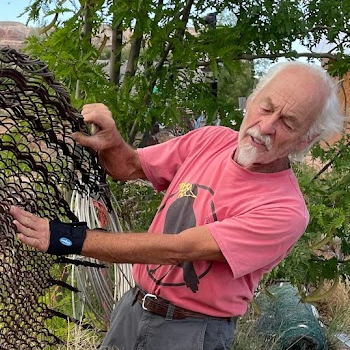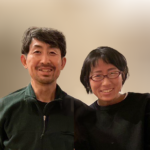Celebrating 20 Years of DesignBuildUTAH
Instructors & Artists

Joe Pachak
South West Local artist
Artist Joe Pachak made his first sculpture at age 11 while growing up in Pueblo, Colo., and he has been at it ever since. He moved to Blanding in 1983 to teach drawing and art history at Utah State University and the White Mesa Institute. In 1988, he moved to Bluff because, as he often says, “I heard there was no work there.” A renowned expert on prehistoric rock art, many of Pachak’s sculptures are on display throughout the county, including at the Edge of the Cedars Museum in Blanding and the Bluff Town Park.
https://www.archaeologysouthwest.org/tag/joe-pachak/
https://www.sltrib.com/news/2019/12/23/bluff-artist-joe-pachak/

Kinya Maruyama
Japanese Architect, Educator, Workshop Leader
Kinya Maruyama, an acclaimed architect, educator, and workshop leader, honed his foundational design skills at the Kuwasawa Design School after attending Waseda University. He earned a master’s degree in architecture from Waseda University in 1964 and subsequently gained three years of professional experience in a Swiss architectural firm. In 1968, he established his own architectural practice, “Atelier Mobile,” and from 1969 to 2009, he served as a part-time lecturer and guest professor at Waseda University.
Maruyama has lectured at numerous higher education institutions, including the University of Pennsylvania, University of Texas, University of Utah, University of Washington, and Kuwasawa Design School. He currently serves as a part-time lecturer at Tokyo University of Science and teaches at the University of Grenoble and École Nationale Supérieure d’Architecture de Nantes. As president of the non-profit organization “Tangible Design,” he actively conducts workshops in France, Uganda, and Morocco.
His architectural projects include the Nago City Hall (which received the Architectural Institute of Japan Design Award in collaboration with Team ZOO), Nakijin Community Center, Akane Garden (a Center for children with intellectual disabilities), Hikari Kindergarten, Kaze no Ko Kindergarten, Honjo Kindergarten, Onna Village Nakadoma Inn, TAO Rehearsal Hall, and Taisetsu Kindergarten.
Maruyama is dedicated to offering education that combines architectural theory and practice and to providing workshops that expand specialized knowledge and practical experience.
https://www.youtube.com/channel/UCHXipdD1cPwFU4vxu1FP5kQ

Naoki Kusumi
Japanese plasterer
Naoki Kusumi is a notable Japanese plasterer, whose extraordinary artistry and exceptional technical skill, honed over more than three decades, bring a timeless beauty to fruition. His works, inspired by ancient techniques passed down through generations, embody the harmonious integration of nature with human creativity. With each stroke of his trowel, organic elements merge in a unique fusion, creating captivating textures that evoke a sense of tranquility. Experience the exquisite mastery of Naoki through his breathtaking creations, and encounter the essence of Japanese aesthetics at our event.

Saido Higuchi
Landscape Designer Focused on Harmonizing Nature and Humanity
After graduating from high school, Saido Higuchi went to France, where he worked on site construction at the “Albert Kahn Gardens” in Paris. Upon returning to Japan in 1993, he joined Takano Landscape Planning and spent 13 years engaged in domestic and international landscaping design and supervision. Emphasizing the coexistence of nature and people, he has created numerous works that leverage the local climate and culture. As the founder and representative of Offside Planning, he has undertaken significant projects. In 2006, he was responsible for the landscape design of the “Earth and Mud Museum” in Tokoname City, Aichi Prefecture – the founding place of INAX – which won him the 12th People-Friendly Urban Design Award. In collaboration with the studio of Arata Isozaki, he participated in international projects such as the site planning for the “National Contemporary Art Center (NCCA)” in Tashkent, Uzbekistan and the “ASTANA Sakura Tree Planting Project” led by Toshiba. As one of Japan’s leading landscape designers, his works are highly esteemed both in Japan and abroad.

Shuhou Sakurai
Flute maker
Sakurai’s description herBefore Shuhou’s born days, he listened to Rampal. During childhood, he had a file and played around with shaving pieces of flute. Until he was twenty years old, Shuhou had various experiences which afterwards he faced making the flute. When he was 25 years old, he was interested in theater and joined Tatsuo Kaneshita’s theatrical workshop ”Zin-no-Totou” as an actor. One year later, Shuhou debuted the theater “DONZOKO” and organized the modern theatrical unit “FRAGILE” with Kiyoshi Kosato, Yosuke Watanabe. He covered the direction part for “Yoshin” ”HARU to SHURABA” and others. He left “FRAGILE” in 2002. At the same time with his theatrical work, he continued making flutes and visited Switzerland, Germany and Austria. He communicated and studied with a local flute player and maker. He also held many workshops in instrument making. His organized the drama “Changing Room” as a member of Seinendan, it came up for the whole theatrical field. After getting married, he moved to Oiso in Kanagawa prefecture and opened Shonan Atelier. His is now executive of Sakurai Flute.

Tomohito and Nagisa Minowa
Japanese farmer
After engaging in the field of landscape design in his 20s, Minowa returned to his hometown in Chiba to start his own farm where he grows rice and soybeans. Minowas pursue a lifestyle in which they integrate food and farming, “Satoyama” landscape, and the local people in the region. While practicing the “duck-rice farming” method, which avoids the use of pesticides or chemical fertilizers, Minowas have organized farming events as well as Tambo (rice field) Art projects both in Japan and overseas. They are also strongly interested in food education for children, and their recent practice includes teaching a rice-growing class at a local elementary school. Minowas are excited to take part In this project, sharing Japanese agriculture and food with the participants while creating a space to celebrate the 20th anniversary of this unique project.

Ken Miyachi
Japanese Lumberjack
I work as a lumberjack. In the mountains, I engage in tree felling, thinning, pruning, and clearing brush. In urban areas, I conduct specialized tree removal under challenging conditions, including pruning and cutting work.
While my practices are not rooted in Japan’s ancient traditional forestry, I tirelessly apply the accumulated wisdom and discernment passed down from my forebears in my daily operations.
I live with the hope that, even if we cannot achieve complete symbiosis with nature, the interaction between contemporary society and trees can become more seamless than it currently is.

Atsushi, Hiroko, Shizuku, Konoha
Staff
While both Atsushi and Hiroko were architecture students in Japan they participated in a number of practical architecture workshops organized by architect Kinya Maruyama and plasterer Naoki Kusumi. There, they learned the appeal of working together with their peers to create things with their hands, which greatly influenced their current jobs. Currently, the two of them are co-directors of the Design Build Utah program in Utah, USA, and have been providing the program together with the University of Utah for over 10 years. While raising two daughters and a dog, the family explores daily to provide interesting architectural education on the red lands of the Navajo Nation, one of the Native American tribes’ land.
